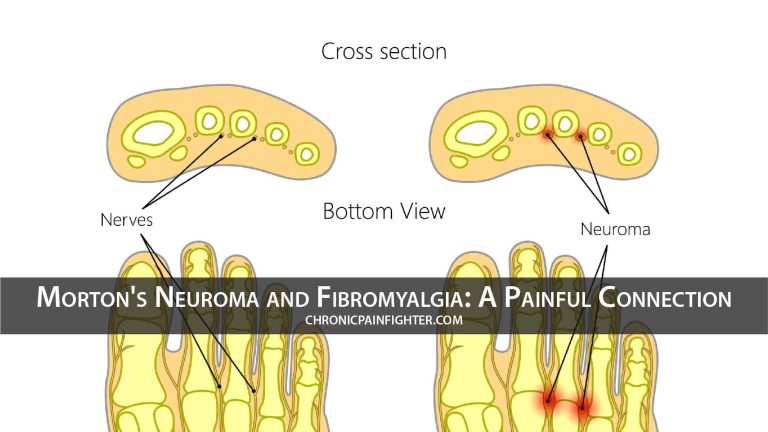Morton’s neuroma and fibromyalgia are two distinct conditions, but they can often intertwine, creating a complex and debilitating experience for those who suffer from both.
Morton’s neuroma is a painful condition that affects the nerves in the foot. It typically develops in the ball of the foot, between the third and fourth toes, or between the second and third toes. Fibromyalgia, on the other hand, is a chronic condition characterized by widespread musculoskeletal pain, fatigue, sleep disturbances, and cognitive issues like brain fog.
While these conditions seem different, they share a common thread: pain. For those dealing with both, the pain can be amplified, making daily life incredibly challenging.
Understanding the Connection
The link between Morton’s neuroma and fibromyalgia isn’t fully understood, but several factors suggest a potential connection:
1. Shared Pain Pathways: Both conditions involve nerve pain. In Morton’s neuroma, the nerve in the foot is compressed, leading to pain, numbness, and tingling. Fibromyalgia, though not directly related to nerve compression, affects the central nervous system, leading to widespread pain and altered pain perception.
2. Central Sensitization: Fibromyalgia is characterized by central sensitization, a condition where the central nervous system becomes hypersensitive to pain signals. This heightened sensitivity could potentially amplify the pain from Morton’s neuroma, making it feel more intense and persistent.
3. Amplified Pain Perception: The increased sensitivity to pain associated with fibromyalgia may make the pain from Morton’s neuroma feel more severe, even if the actual nerve damage is relatively minor.
4. Increased Risk Factors: Some researchers suggest that individuals with fibromyalgia may be more susceptible to developing Morton’s neuroma due to factors like altered foot biomechanics and increased inflammation.
Recognizing the Symptoms
Understanding the symptoms of both conditions is crucial for accurate diagnosis and treatment.
Morton’s Neuroma:
- Burning, sharp, or shooting pain in the ball of the foot
- Numbness or tingling in the toes
- Pain that worsens with activity and pressure on the foot
- Feeling like you are standing on a pebble
Fibromyalgia:
- Widespread musculoskeletal pain lasting at least 3 months
- Tender points: Specific points on the body that are extremely sensitive to touch
- Fatigue
- Sleep disturbances
- Cognitive issues (brain fog, memory problems, difficulty concentrating)
- Depression and anxiety
Diagnosis and Treatment
If you experience both foot pain and symptoms consistent with fibromyalgia, it’s essential to consult with a doctor.
Diagnosis:
- Physical Exam: Your doctor will examine your foot and ask about your symptoms and medical history.
- Imaging Tests: X-rays, ultrasound, or MRI scans may be used to rule out other conditions and confirm the presence of Morton’s neuroma.
- Nerve Conduction Studies: These tests measure the speed of nerve impulses, which can help assess nerve damage.
Treatment:
- Conservative Treatment: For both conditions, conservative treatments may be effective. These include:
- Over-the-counter pain relievers (NSAIDs)
- Orthotics (arch supports or shoe inserts)
- Rest and avoid activities that worsen pain
- Physical therapy to strengthen foot muscles and improve biomechanics
- Corticosteroid injections (for Morton’s neuroma)
- Surgery: Surgery for Morton’s neuroma is typically reserved for severe cases that don’t respond to conservative treatment.
Managing the Pain
Living with both Morton’s neuroma and fibromyalgia can be challenging, but there are strategies to manage pain and improve quality of life.
Pain Management:
- Medications: Your doctor may prescribe pain relievers, antidepressants (for pain and mood), or anticonvulsants (for nerve pain) to help manage pain.
- Lifestyle Modifications: Healthy habits like exercise, a balanced diet, and stress management techniques can help manage pain and improve overall well-being.
- Complementary Therapies: Alternative therapies like acupuncture, massage therapy, and yoga may offer additional pain relief and stress reduction.
- Support Groups: Connecting with others who understand your experience can provide valuable emotional support and coping strategies.
Living with Both Conditions
Living with Morton’s neuroma and fibromyalgia is a journey that requires patience, persistence, and a strong support system. It’s crucial to work closely with your healthcare team to develop a personalized treatment plan that addresses both conditions.
Tips for Living Well:
- Listen to your body: Pay attention to your pain levels and modify your activities accordingly.
- Find ways to manage stress: Stress can worsen pain. Explore stress reduction techniques that work for you, like deep breathing exercises, meditation, or yoga.
- Prioritize sleep: Getting adequate sleep is essential for pain management and overall health.
- Stay active: Exercise can help improve muscle strength, flexibility, and pain tolerance. Choose activities that don’t aggravate your foot pain.
- Seek support: Don’t hesitate to reach out to your healthcare providers, family, friends, or support groups for help and guidance.
Remember, you are not alone. There are resources and support systems available to help you manage pain and live a fulfilling life despite these challenges.






